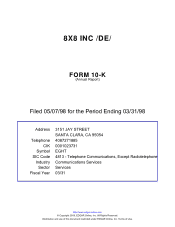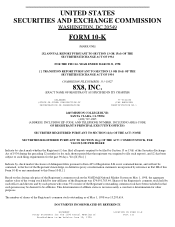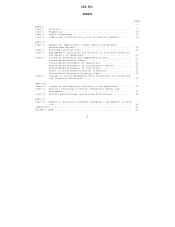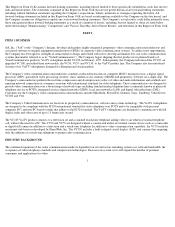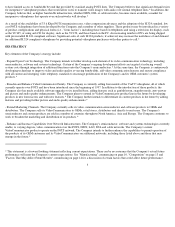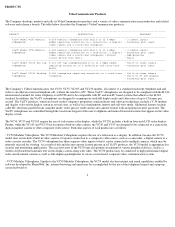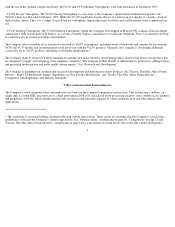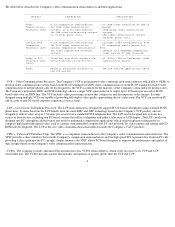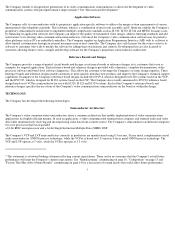8x8 1998 Annual Report Download - page 11
Download and view the complete annual report
Please find page 11 of the 1998 8x8 annual report below. You can navigate through the pages in the report by either clicking on the pages listed below, or by using the keyword search tool below to find specific information within the annual report.
The Company intends to design future generations of its video communication semiconductors to allow the development of video
communication systems with price/performance improvements.* See "Research and Development."
Application Software
The Company sells its semiconductors with its proprietary application specific software to address the unique system requirements of various
international video telephony standards. This software, which is a combination of microcode assembly and C firmware, enables the Company's
proprietary semiconductor architecture to implement multiple compression standards such as H.320, H.323, H.324 and MPEG. In many cases,
by enhancing its application software, the Company can improve the quality of transmitted video images, address emerging standards and add
user features to its existing video communication semiconductors. Certain of the Company's video communication software may be ported to
other platforms such as PCs or embedded controllers. The Company supplies an Application Programmers Interface (API) with its software to
allow limited customization through an external microprocessor or host controller. The Company also sells licenses for the source code for its
software to customers who wish to modify the software by adding their own features and controls. Development kits are also licensed to
customers allowing them to write, compile and develop software for the Company's proprietary semiconductor architecture.
Reference Boards and Designs
The Company provides a range of printed circuit boards and designs as reference boards or reference designs to its customers that serve as
examples for targeted applications. Each reference board and reference design is provided with schematics, complete documentation, video
processor software and board-level software diagnostics. This allows the customer to leverage the Company's systems design expertise. These
reference boards and reference designs enable customers to more quickly introduce new products and improve the Company's technical support
capabilities. Examples of the Company's reference board designs include the DVC9-I, which is designed for H.320 systems based on the VCP,
and the DVC9-P, which is designed for H.324 systems based on the LVP. The Company also recently announced its DVC10 reference board
design based on its VCPex semiconductor for use with H.320, H.323 and H.324 systems. Each of the Company's reference boards and
reference designs specifies the use of one of the Company's video communication semiconductors on the board or within the design.
TECHNOLOGY
The Company has developed the following technologies:
Semiconductor Architecture
The Company's video communication semiconductors share a common architecture that enables implementation of video communication
applications in a highly efficient manner. In such an application, a video communication terminal must compress and transmit audio and video
data while simultaneously receiving and decompressing video data from a remote source. The Company's semiconductor architecture integrates
two core processors that run in parallel:
a 32-bit RISC microprocessor and a 64-bit Single Instruction Multiple Data (SIMD) DSP.
The Company's VCP and LVP semiconductors currently in production are manufactured using 0.5 micron, 3-layer metal complementary metal
oxide semiconductor (CMOS) process technology, while the VCPex is based on 0.35 micron, 4-layer metal CMOS process technology. The
VCP and LVP operate at 5 volts, while the VCPex operates at 3.3 volts.
* This statement is a forward looking statement reflecting current expectations. There can be no assurance that the Company's actual future
performance will meet the Company's current expectations. See "Manufacturing" commencing on page 10, "Competition" on page 13 and
"Factors That May Affect Future Results" commencing on page 14 for a discussion of certain factors that could affect future performance.
7

